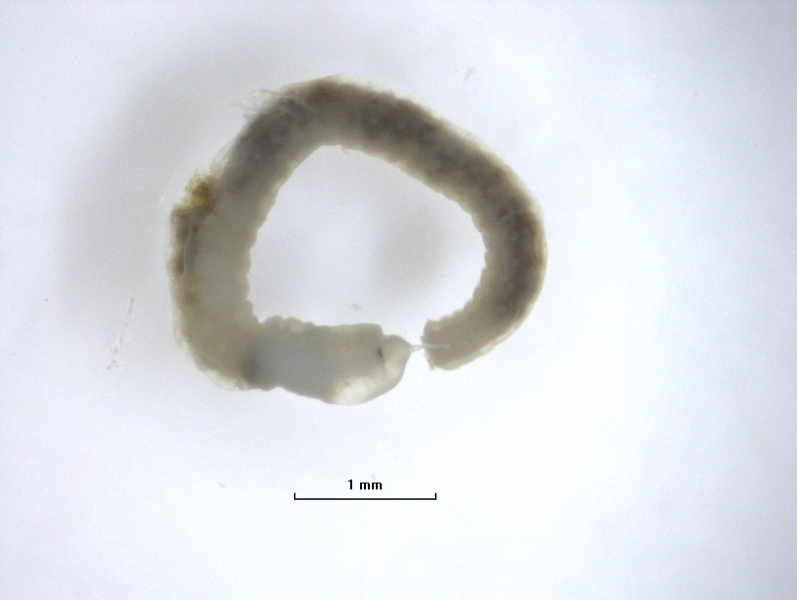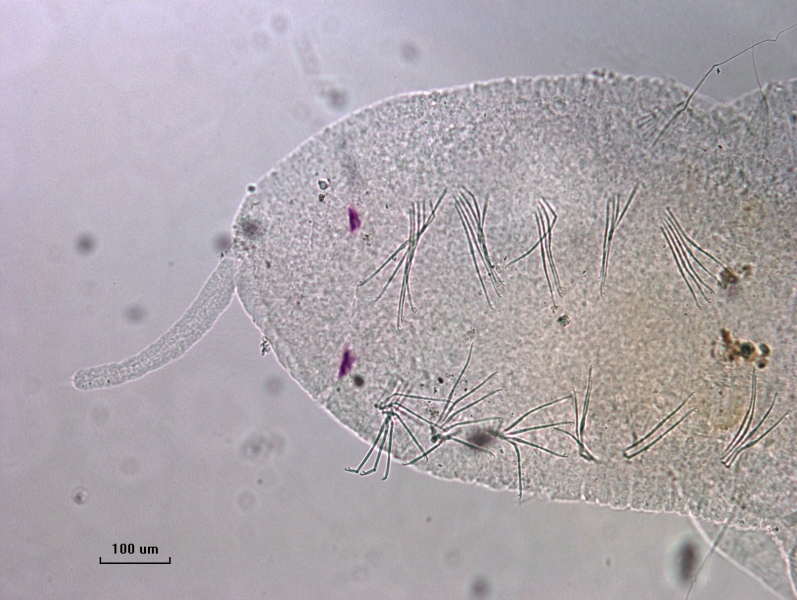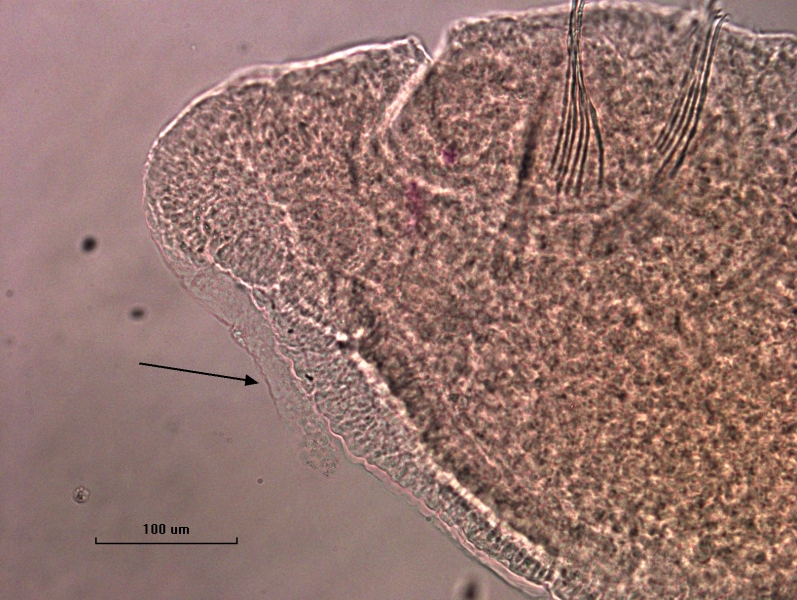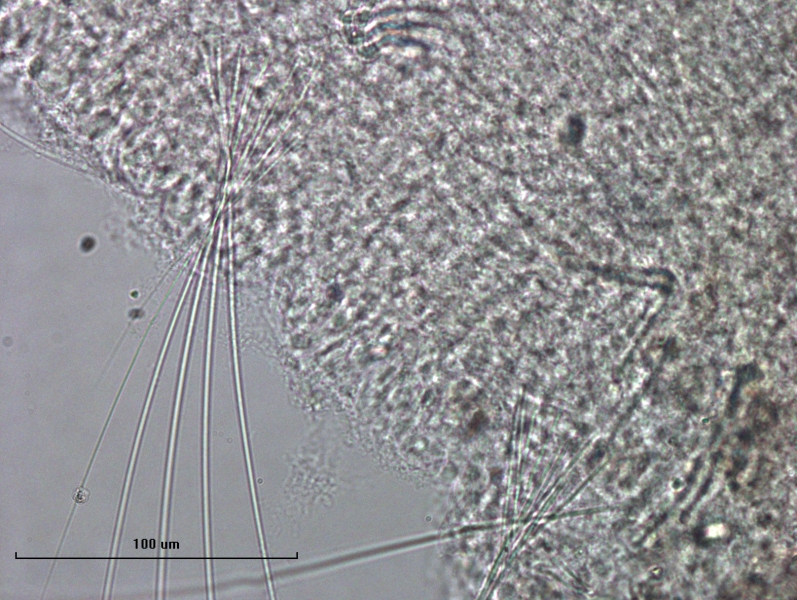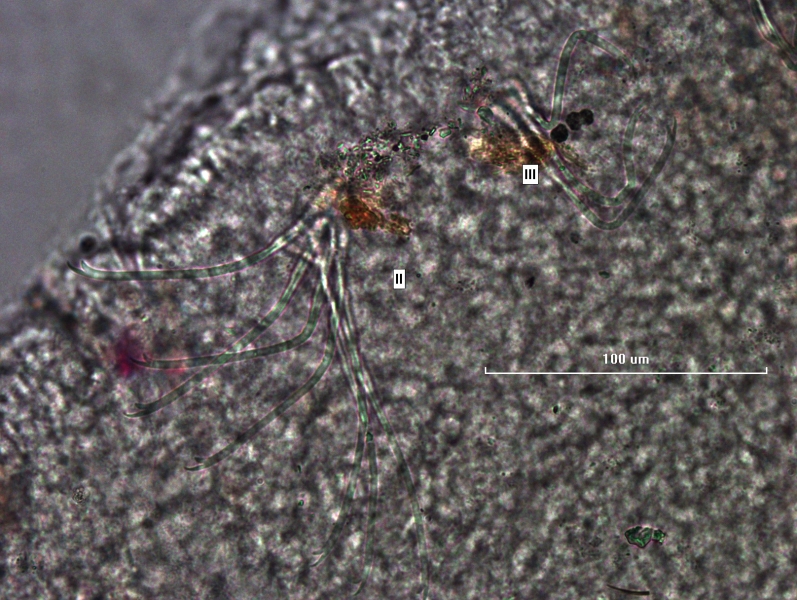Arcteonais lomondi
Taxa description
Arcteonais lomondi (Martin, 1907) is a freshwater oligochaete worm that is common in the Great Lakes. It is a naidid worm with dorsal bundles starting in VI and ventral bundles beginning in II, hair chaetae, and usually having a proboscis, although it may be broken. A. lomondi has numerous dorsal chaetae (up to 8–18) with some fine, straight simple-pointed needles without a nodulus (up to 9–12); however, many American specimens have fewer dorsal chaetae. The dorsal hairs often form a tent structure, all crossing at point near the proximal end. Ventral chaetae begin in II, and are thicker and longer in II, decreasing in length to V. Ventral bundles contain 3–7 sigmoid chaetae with the upper teeth longer and slightly thinner than the lower. There may or may not be eyes. If mature, there is a thickened clitellum and up to 4 penial chaetae in VI.
Distinguishing features
A. lomondi is identified by the dorsal bundles with hair chaetae and simple-pointed needles beginning in VI, sometimes numerous hair chaetae in a tent shape, sigmoid ventral chaetae with upper tooth longer and slightly thinner than lower, ventrals of II thicker and longer than the rest, and anterior ventral chaetae decreasing in size to V. This species usually has a proboscis but in practice the proboscis may be torn off or obscured when mounted. In that case, rely on the chaetae.
Habitat
This species dwells in fresh water, typically in shallow waters on silty substrata.
Lake occurrence
This species occurs in all five Great Lakes, though less likely from Lakes Ontario and Superior due to station depth.
Similar species
The features of A. lomondi are very distinctive, but there are a few other oligochaetes that could look similar. Stylaria lacustris, S. fossularis, and Ripistes parasita all have bundles with hair chaetae starting in VI and a proboscis. S. lacustris is found in our samples, but R. parasita has not been, so A. lomondi is most likely to be confused with the former. S. lacustris has a long proboscis starting from between invaginated lobes; S. fossularis has a long proboscis starting from the end of the conical prostomium. The hair chaetae are less numerous in S. lacustris and S. fossularis and they do not form a tent shape. The ventral chaetae of S. lacustris have a double-bend at the proximal end, and all are the same length. S. fossularis may only have one bend at the proximal end. S. lacustris and S. fossularis may or may not have eyes, similar to A. lomondi. R. parasita has a variable proboscis starting from the end of the prostomium. It has up to 16 giant hair chaetae in VI–VIII, along with up to 6 shorter hairs and up to 18 simple-pointed needles in every dorsal bundle. Hairs in posterior bundles may be shorter, thicker, and appear hispid. A. lomondi does not have giant or hispid hair chaetae, but it may have numerous hairs and needles. R. parasita does not have a tent-shaped cross at the proximal end of the dorsal bundles. The ventral chaetae of II are longer than III with the upper tooth longer than the lower, but IV and V lack ventral chaetae, and posterior chaetae are thicker with the upper tooth shorter than the lower. The ventrals have a sharp bend instead of being curved. A. lomondi usually is not missing ventral chaetae in IV and V.
The main source of confusion with this species can occur if the proboscis is missing, since it will not key out properly. If it is lacking a proboscis, the only other oligochaete with numerous hair chaetae starting in VI is Vejdovskyella. V. intermedia is more likely than V. comata in our samples. V. intermedia lacks eyes and a proboscis, has 4–9 long hispid, bifid hair chaetae and 4–9 simple needles with broad tips, has anterior ventral chaetae decreasing in size to V, single ventral chaetae starting in VI and beyond, VI–VIII may have giant chaetae with thin replicated upper teeth, and there may be foreign matter attached. V. comata has 4–8 hispid hairs and 1–8 simple needles with broad tips that may appear to start in V because there are no ventrals in V, usually has eyes but no proboscis, has anterior ventral chaetae decreasing in size to IV with V and maybe IV absent, 2–3 ventrals starting in VI, occasionally a single giant chaetae with a single thin upper tooth in VI–VIII, and scattered papillae on the body wall. A. lomondi does not have hispid hairs or giant ventral chaetae and does have a proboscis.
Relative size
A. lomondi is generally a small oligochaete worm but is often one of the larger naidid worms.
Does it have a barcode reference from the Great Lakes?
Yes, this species does have a barcode reference from the Great Lakes.
References
Chekanovskaya, O.V. 1962. Aquatic Oligochaeta of the USSR. Key to the Fauna of the USSR. p. 200.
Kathman, R.D., and R.O. Brinkhurst. 1998. Guide to Freshwater Oligochaetes of North America. p. 62–63, 34, 38, 78–79.
Hiltunen, J.K., and D.J. Klemm. 1980. A Guide to the Naididae (Annelida: Clitellata: Oligochaeta) of North America. pp. 19, 32.


